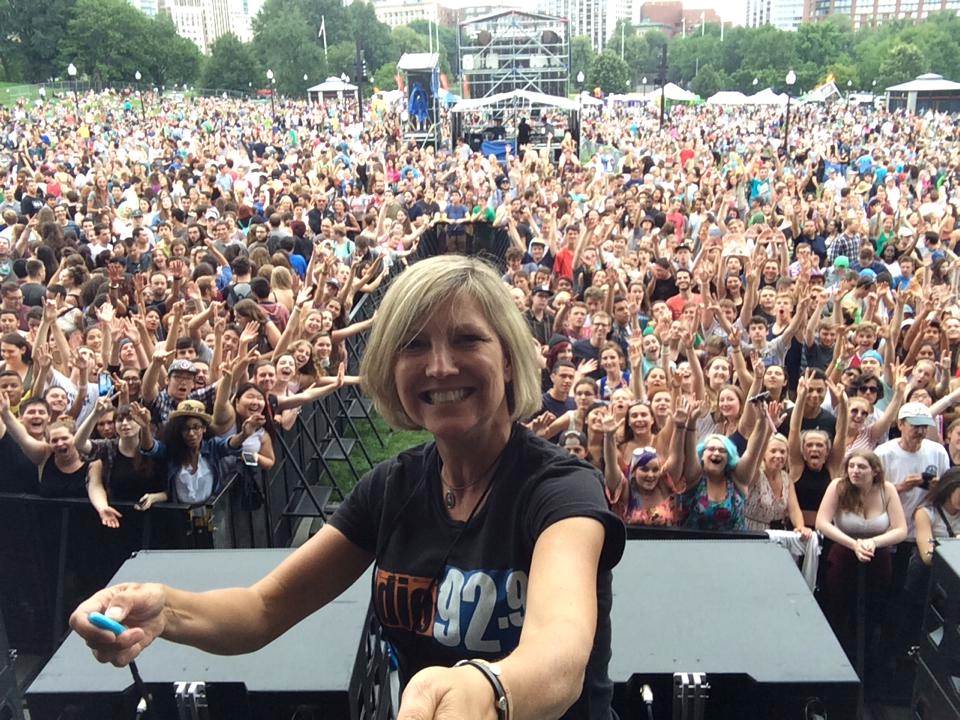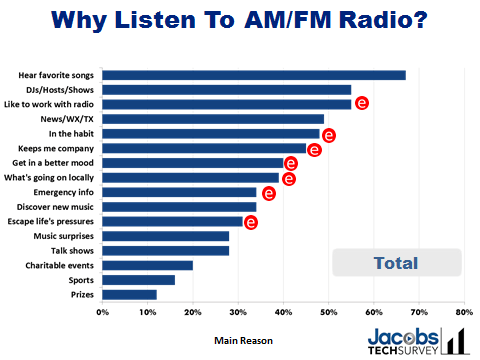We continue to read more and more about how big data will continue to dominate the business world, helping corporations and brands steer their ships, while collecting more info about their customers’ tastes, behavior, and purchases.
But a recent article in MediaPost’s “Cross-Channel” by Stacia Hanley debunks some of today’s conventional wisdom about the process of evaluating media and marketing relying on the metrics while missing the larger point.
Radio should be all ears.
Her premise is that while data is a wonderful way to manage businesses, marketers and company executives should use that information to dream up more exciting possibilities to engage customers, including:
“How our communications strategies can involve and benefit from a more human touch.”
A human touch. Connecting and engaging with audiences and communities in which they live. It’s radio’s USP and it has nothing to do with metrics, and everything to do with emotional bonds.
Consumers don’t care about your data, your M Scores, your rankers, or your EBITDA. Even the process of making content more targetable via email, social media, and programmatic buying doesn’t change the reality of that data-driven marketers often do not truly understand the customers they’re attempting to reach.
Chances are, you’ve seen this chart from Techsurvey11 before. At a Conclave presentation last week, it may have been the most important one of the 65 slides I showed. That’s because while the meat and potatoes radio product – music and DJs – are at the core of listenership, the emotional elements truly provide the uniqueness that only broadcast radio offers.
Those little red “e’s” stand for the emotional benefits of radio listening that Hanley wrote about. Companionship, emotional uplift, stress relief, escape, and a sense of place. These are more important to an audience trying to derive benefit from your station. To broadcasters, they should be more meaningful than conjuring up more data-targeted advertisements and deals.
And while these surveys can help you identify these emotional underpinnings, your programming, sales, digital, and marketing staffers have the onus of translating these touch points into viable programming and targeted content that deliver on this emotional values.

Understanding why listeners are hiring your station – when they could be listening to commercial-free music on SiriusXM, Spotify, or Pandora, or caffeinated DJs on Beats1 – are what the data tell you about your product and its relationship to your hometown audience. That’s the science.
The art is bringing these emotions to life, connecting with your listeners where they live, work, and play, and touching their lives in ways that only broadcast radio can.
Human emotions are not scalable. All the data and metrics in the world won’t solve your problems if you don’t understand the jobs that listeners are hiring you to do.
We’ve overreacted to the science of P/E ratios, meters, and music scheduling.
Time to emphasize the emotional art.
- What To Do If Your Radio Station Goes Through A Midlife Crisis - April 25, 2025
- A 2020 Lesson?It Could All Be Gone In A Flash - April 24, 2025
- How AI Can Give Radio Personalities More…PERSONALITY - April 23, 2025






Flesh-and-blood is the best algorithm
Great line! Thanks, Dimitri.
Bravos, Fred. Well said. It’s easy to get pulled into the rabbit hole of rocket surgery and forget that, at its best, Radio is a performance art. Here’s an excerpt from a 1974 memo by the brilliant Chuck Blore written when he was programming KIIS in Los Angeles.
“The presenters, the on-air personalities, are likeable, intelligent, charismatic people who are obviously in love with what they are a part of. What they must do is ask themselves, with everything they prepare, ‘Does what I am about to do, or say, matter to the audience?’ Remember that everything we do is done from the audience’s point of view. Everything is a constant, non-stop answer to the audience’s non-spoken question, ‘Why should I listen to this station? What’s in it for me?’ And this is not something that can be done part of the time. When a person tunes to the station they should hear the difference at once.”
Let’s remember the wise counsel of Penn Jillette, “In all of art, it’s the singer, not the song.”
Chuck would have been a great programmer to help guide radio through the turbo-charged, digital morass in which all stations must compete. Amazingly on-point comments that are as timely today as they were four decades ago. Thanks, as always, for the kind words, Dave.
Once again, great food for thought. The art is bringing it all to life. Whether its on the radio, or on a FB post, or a tweet you send out, I always like to say “Make me care.” There’s no amount of “data” that can make me care. I love to listen to Ray Koob and Andre on WMGK in Philly. No matter how many times they play the same song by Zeppelin, or Foreigner, they always bring a high level of emotional connection to the songs – and as many times as I have heard these songs, they remind me of why I care, and I stay tuned in, turning the volume up.
Bruce, thanks for the note, and for pointing out there are stations on the commercial side of the street, like MGK, that create a great music experience because of their passion and knowledge of the music. Their success in recent years has to be attributable to that personal touch, because as we know, consumers can put together their own “perfect playlists,” commercial-free.
We humans tend to enjoy articles that support our views & theories! Thanks for this one. I’m pretty sure we all believe media and advertising are part- art, part-science. We need a healthy mix of left-brains and the right-brains in stations, etc.
The digital era is of course delivering big-time (Salesforce, mobile marketing, programmatic, “big data”, etc).
Digital, TV and Radio are all Media, but each has their important attributes and distinctions.
Let’s remind and encourage those in charge to not just deploy one standard and strategy cross all of their Divisions. Especially RADIO – per all the great points in this article and supporting research.
Rob, there is no one-size-fits-all. It’s a brand by brand proposition. The edict that some companies issued a few years ago that every jock had to blog every day was an unrealistic, monolithic strategy that didn’t work. Some stations have a great personality lineup while others are going to have to get it done with other tools. If you know your brands, your audience, and your community, this stuff isn’t as hard as it looks. Thanks for the comment.
From the mid-1920s to perhaps the mid-1940s, radio delivered for its sponsors by making the show hosts/stars part of the sponsor’s family. Think about Jack Benny and Jell-o. When Captain Midnight told you to send in the inner seal from an Ovaltine jar you pestered your parents to buy it for you (it made me gag). In the Top 40 era, when a jock you to buy a particular brand of pimple cream the next day at school everyone sported that false flesh tone color in little dots all over their faces.
Now, the talent is separate from the commercials. Many live spots are read by production managers instead of the jocks or hosts the listeners connect with. There is hardly time in formats for hosts to include those personal touches that made them your pals instead of voices in the background. There’s buzz about programmatic advertising as the next big thing, so as a host you’ll have no idea what ad is being delivered in your show. Good luck making a personal comment about an advertiser.
Yet I’ve had consultants (present company excluded) tell me this is all a good thing and this is the way radio is done today. Honestly, I don’t get it.
Jay, while programmatic is the new bandwagon, the essence of what made radio advertising most effective is exactly what you’re talking about. I think back to the way that Jim Harper leveraged advertisers using the personal touch (not just live reads, but taking care of a select group of companies and local retailers who were looking for something high level and special). Sadly, some advertisers want the live reads to stand out in a cluster, rather than allowing a creative morning show or host to play with the copy a bit and add a personal touch. Jay, this is definitely a case of radio trying to follow the trends without losing its essence – always a dance. Thanks for taking the time chime in.
Funny that prizes are dead last. Radio is all about the fall promotions…win a cruise…but I suppose that is just a sales idea that has nothing to do with the connections you mentioned,
Then again, we know that contests result in the same people calling in month after month. They just want free stuff.
On a more positive note, I was at our station trailer today at the Collingwood Elvis Festival, and had a guy raving about the rock and roll show that runs on 97.7 on Friday and Saturday nights…my show…and he was thrilled to discover that he was chatting with the host.
An emotional connection!
The prize thing is always interesting because while they test poorly, they often move the needle. Many say the same people who would carry a diary or a meter are predisposed to want to win stuff. I believe that. But as you point out, the intangible is the emotional connection with a station and its personalities. And that’s something that’s key for radio as we battle new competition for people’s ears and their hearts. Thanks for taking the time to offer your perspective.
Radio is not about transmitters, buildings, music etc. it’s about people. People make the business fun; personalities behind the microphone and personalities on the street selling the ads. Strong personalities on both sides of the mic are what make for a winning radio station. Neither can be taken for granted.
Competition for talent that has proven it draws a big audience, not just on-the-air but also online and through social media has never been more sought after. Competition for talent that can package, present and close advertising sales also has never been in more demand.
Your best ROI will come from the people you have invested in.
Amen, Dick, and let’s hope that message continues to get across to broadcasting’s C-suitors. As we’re seeing, radio’s competitors are figuring it out. Thanks for the comment.